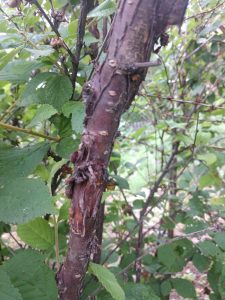What’s wrong with my stone fruit trees and shrubs?
Question:
 We have quite a few stone fruit trees/shrubs in our yard, including sour cherry bushes, apricots trees, and plum trees. This past spring the blossoms on these shrubs and trees browned, and many of the younger branches died. We only got a fraction of the fruit that we usually do, but the fruit that did form didn’t show any sign of disease. I’m not sure if my diagnosis is correct, but it seems consistent with brown rot blossom blight. I’ve only gotten around to addressing it now. There is new growth at the base of the dead branches, and I have been using clippers (and a bleach solution) to remove the dead branches. My questions are these:
We have quite a few stone fruit trees/shrubs in our yard, including sour cherry bushes, apricots trees, and plum trees. This past spring the blossoms on these shrubs and trees browned, and many of the younger branches died. We only got a fraction of the fruit that we usually do, but the fruit that did form didn’t show any sign of disease. I’m not sure if my diagnosis is correct, but it seems consistent with brown rot blossom blight. I’ve only gotten around to addressing it now. There is new growth at the base of the dead branches, and I have been using clippers (and a bleach solution) to remove the dead branches. My questions are these:
- Does this diagnosis sound right?
- Can these bushes overcome the infection by themselves?
- Some websites suggest pruning to 8 inches below the last infected branch. But that would have me pruning the cherry bushes almost to the ground. I’ll do that if I have to, but I would really rather not.
- If I don’t get it all, will the infection get worse next year?
- Do I need to do some sort of chemical treatment? Again, I would really rather not, but I will if I have to.
- Will this always be a problem? Or was there something about this spring that was unusual?
Answer:
Caragh B. Fitzgerald, Associate Extension Professor
I shared the photos with our plant disease diagnostician, and she thinks it may be fire blight, which she is seeing quite a bit of this year. Feel free to submit a sample to the diagnostic lab so we can be sure, though. Here are instructions for sampling (submission form and video of how to collect and package samples). If you know the specific species and variety names of your fruit trees, that might help. Varieties vary in their susceptibility to fire blight.
Pruning affected branches is a great first step for either disease. For fire blight, prune 8-12 inches below the affected areas, and sterilize between cuts, as you have been doing. It can be helpful to wait until winter to prune, though. The bacteria that cause fire blight can spread more easily in the summer.
Specific management information can be found in this fact sheet, Fire Blight (PDF) from Colorado State University Extension.
